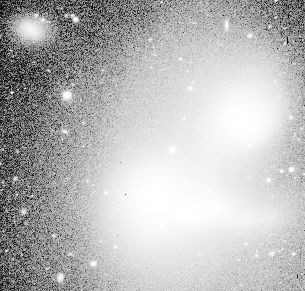


3.2.1. Groups of Galaxies
These are small scale structures with
radii typically  0.5-1.0 Mpc and
which contain a few (3-10)
prominent Galaxies. They have overdensities which average around
0.5-1.0 Mpc and
which contain a few (3-10)
prominent Galaxies. They have overdensities which average around

 /
/ 
 80 (Ramella et al. 1994).
Most of these groups are only weakly gravitationally
bound. Our own Local Group is a good example, consisting by number
of dwarf galaxies (undetectable in more distant groups) and by mass
of the Milky Way and M31. M33 is a minor mass constituent. The
large spiral IC 342 might be a dynamically important portion of
the Local Group as its distance remains uncertain. There is also
recent evidence that a galaxy known as Maffei I might also be
dynamically important. Maffei I is difficult to study as it is
located at a galactic latitude of only +0.6° and hence is heavenly
reddened. This is unfortunate as Maffei I is undoubtedly the
closet elliptical galaxy to the Milky Way. Its distance may be
as near as 3 kpc and, together with IC 342, it may form a small
system similar to the Local Group (Krismer et al. 1995).
Indeed, two dwarf galaxies associated with this system have also been
recently discovered (McCall and Buta 1995).
80 (Ramella et al. 1994).
Most of these groups are only weakly gravitationally
bound. Our own Local Group is a good example, consisting by number
of dwarf galaxies (undetectable in more distant groups) and by mass
of the Milky Way and M31. M33 is a minor mass constituent. The
large spiral IC 342 might be a dynamically important portion of
the Local Group as its distance remains uncertain. There is also
recent evidence that a galaxy known as Maffei I might also be
dynamically important. Maffei I is difficult to study as it is
located at a galactic latitude of only +0.6° and hence is heavenly
reddened. This is unfortunate as Maffei I is undoubtedly the
closet elliptical galaxy to the Milky Way. Its distance may be
as near as 3 kpc and, together with IC 342, it may form a small
system similar to the Local Group (Krismer et al. 1995).
Indeed, two dwarf galaxies associated with this system have also been
recently discovered (McCall and Buta 1995).
In addition to loose, weakly bound groups there are tightly bound
compact groups. These compact groups are curious in that they
have dynamical timescales (crossing times) of a few x 108 years.
These apparently short
dynamical timescales have led many to conclude that these groups
can't be real, but instead are accidental projections of a few
galaxies. However, given the
 100-200 compact groups which
have been cataloged, this explanation seems untenable - many
of these groups must be real. This reality has recently been
confirmed by the presence of X-ray emission in some compact
groups as detected by the ROSAT satellite. Work by Diaferio
et al. (1995), Ramella et al. (1995) and Pildis
(1995) has shown that the presence of X-ray gas in compact groups
correlates most strongly with that group's membership in a larger grouping of
galaxies. X-ray emitting compact groups also tend to have a low
spiral fraction.
100-200 compact groups which
have been cataloged, this explanation seems untenable - many
of these groups must be real. This reality has recently been
confirmed by the presence of X-ray emission in some compact
groups as detected by the ROSAT satellite. Work by Diaferio
et al. (1995), Ramella et al. (1995) and Pildis
(1995) has shown that the presence of X-ray gas in compact groups
correlates most strongly with that group's membership in a larger grouping of
galaxies. X-ray emitting compact groups also tend to have a low
spiral fraction.
In general, groups of galaxies are fairly spiral rich. Elliptical galaxies constitute a small fraction of the total group population, except in the most compact and dense groups. Since the dynamical timescales in compact groups are relatively short, it is quite possible that the elliptical galaxies which are in compact groups formed as the result of the merger of 2 or more spiral galaxies (e.g., Zepf and Whitmore 1993). Indeed, in some compact groups there is evidence for diffuse intracluster light (see Figure 3-2) which may represent a pre-merger stage. However, many compact groups do not show evidence for diffuse intracluster light which either implies little dynamical evolution (which seems in contradiction with the short inferred dynamical timescale) or have only recently formed into a bound unit. For the present time, the best way to study the formation and evolution of groups (bound or not) is via N-body / hydrodynamical simulations of the collapses of large scale structures. Most of these simulations indicate that group formation is a consequence of what happens on larger scales but the simulations generally lack the resolution to study the group properties in detail (see Bertschinger et al. 1988, Weinberg et al. 1997). Observationally it is rare to find a group that is not connected to a larger scale structure.

|
Figure 3-2: CCD image of Hickson Compact Group 92 taken by the author using the NTT telescope at the ESO observatory. The image shows that much of the group contains diffuse intergalactic light. |